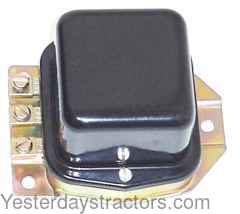Tractor: TE-20 (cont. Motor)
Electric system: 6V
I have the wiring diagrams from FENA for TE and TO tractors.
My Voltage Regulator looks like the one in the picture:
It has three terminals labeled as follows:
BTY - I assume means Battery
ARM - I assume means Armature
FLD - I assume means Field
The tractor came to me 14 years ago hooked up with the wires going from the VR to the three various places directly. Tractor has never seamed to charge the battery correctly. Not sure if it is a Genny, VR or wiring issue.
I was cleaning all my wiring up and reviewing the wiring diagrams and now I am confused over the VR terminals and labels,
On the TE/TEA wiring diagram the VR is labeled with terminals:
F - goes to Field of Genny
A- goes to the battery with the amp meter in the line.
E- Goes to Ground
D- Goes to Armature of Genny
On the TO-20 diagram /amp meter the VR is labeled with:
F - goes to field of genny
L - goes to the ignition switch
B - goes to the battery with the amp meter in the line.
G - goes to the armature of the genny.
On the TO-20 diagram with the red light charge indicator (From the "on the Farm Service Manual" the VR is labeled with:
Field - goes to field of genny
Load- goes to the ignition switch
Battery- goes to the battery
Generator- goes to the armature of the genny.
Can you help me correlate all this an what my three terminals would be equivalent to on the TE-wiring diagram.
Thank you.
Jeff

Electric system: 6V
I have the wiring diagrams from FENA for TE and TO tractors.
My Voltage Regulator looks like the one in the picture:
It has three terminals labeled as follows:
BTY - I assume means Battery
ARM - I assume means Armature
FLD - I assume means Field
The tractor came to me 14 years ago hooked up with the wires going from the VR to the three various places directly. Tractor has never seamed to charge the battery correctly. Not sure if it is a Genny, VR or wiring issue.
I was cleaning all my wiring up and reviewing the wiring diagrams and now I am confused over the VR terminals and labels,
On the TE/TEA wiring diagram the VR is labeled with terminals:
F - goes to Field of Genny
A- goes to the battery with the amp meter in the line.
E- Goes to Ground
D- Goes to Armature of Genny
On the TO-20 diagram /amp meter the VR is labeled with:
F - goes to field of genny
L - goes to the ignition switch
B - goes to the battery with the amp meter in the line.
G - goes to the armature of the genny.
On the TO-20 diagram with the red light charge indicator (From the "on the Farm Service Manual" the VR is labeled with:
Field - goes to field of genny
Load- goes to the ignition switch
Battery- goes to the battery
Generator- goes to the armature of the genny.
Can you help me correlate all this an what my three terminals would be equivalent to on the TE-wiring diagram.
Thank you.
Jeff


